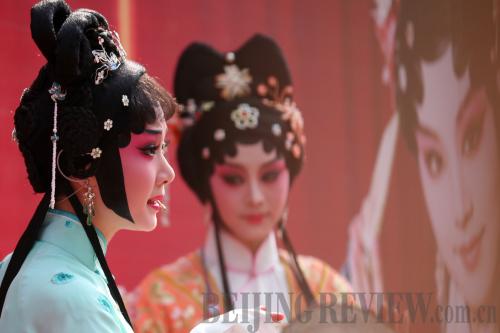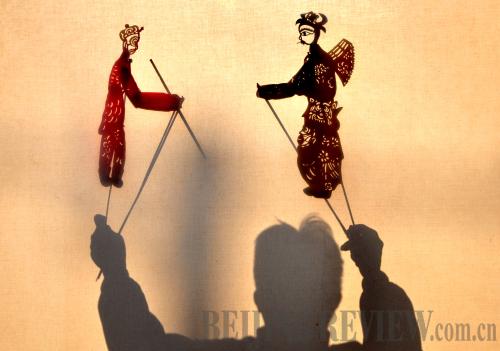|
 |
|
DREAM-LIKE CHARM: Zhu Bingzhen, heroine of the Kunqu Opera play Dream of Red Mansions, performs at the play's press release in Beijing on August 8, 2011 (PU XIANGDONG) |
At the tail of the Chinese Lunar New Year, the whole country is still immersed in gaiety. The joyous atmosphere lingers in the red lanterns along the streets, in the colorful candy wrappers, and in the brilliant folk art performances.
For many Chinese people, old or young, to watch dragon dances, paper cutting, shadow puppetry shows and local dramas is the best part of the festival. All good wishes for a new year burst out at those moments.
Indeed, the various folk art performances have been an indispensable part of this traditional festival since ancient times. As one of the world's oldest continuous civilizations, China has a wealth of intangible cultural heritage. As precious cultural genes of the Chinese nation, some folk arts have been listed as world cultural heritage by UNESCO. In the past two decades, the country has made enormous efforts to identify, recognize and protect such treasures. Shadow puppetry and Kunqu opera are two prominent examples.
 |
|
SHOWTIME: A puppeteer operates two puppets during a shadow puppetry show in Zaozhuang, Shandong Province, on October 15, 2011 (CFP) |
The ancient performing art of shadow puppetry regained center stage after a long period of neglect, after it was newly added to UNESCO's World Intangible Cultural Heritage List on November 27, 2011.
Shadow puppetry is one of China's earliest performance arts. It appeared in the Han Dynasty (202 B.C.-A.D. 220) and became very popular in many parts of the country during the Tang Dynasty (618-907) and Song Dynasty (960-1279).
Shadow puppetry is a combination of performing arts and the carving art. The puppeteers operate the puppets behind a back-lit curtain screen. The audience sees the action unfold as the shadows play across the screen. The puppets, which are made of ox, sheep, or donkey skin, are essential stage props as well as brilliant handcrafted artworks. They present not only the characters, but also all kinds of objects from everyday life, such as clothes, ornaments, towers, pavilions, furnishings, and scenery.
The faces of the shadow figures, including human, supernatural, and animal beings, are carved intricately. Their facial features are often exaggerated. The young heroes and heroines, for example, often have elegant and noble slanted foreheads and noses. Treacherous characters always have extremely large eyes.
The origin of shadow puppet dates back over 2,000 years. It is said that a favorite concubine of Emperor Wu in the Han Dynasty died of an illness. The emperor missed her so much that he lost enthusiasm for life. One day, a minister happened to see children playing with dolls. When they played, the shadows on the floor moved vividly. Inspired by this scene, the smart minister got an idea. He made a cotton puppet of the concubine and painted it.
At night, he invited the emperor to watch a performance. The emperor was very happy to see the lively puppet of the concubine.
However, in modern times, amid the surge of film and television, people gradually lost interest in puppet shows, and the art form faced extinction.
"We should preserve the tradition of our shadow puppetry. We should preserve not only the puppets and props but also the theater texts and music. They are part of Chinese culture. They may help promote Chinese culture and contribute to the creation of new art forms," said Sun Jianjun, a professor at the Academy of Arts and Design at Tsinghua University.
Liu Nianhua, a 57-year-old puppeteer in Qianjiang, central China's Hubei Province, felt the urgency of passing on this ancient art. "I was worried this precious art maybe lost to the world," said Liu.
Currently, there are no more than eight puppeteers in Qianjiang, he said.
But the inclusion of shadow puppetry on the UNESCO list could provide a vital lifeline to the dying art form. Since then, a flood of visitors have rushed to Haining, east China's Zhejiang Province, to appreciate puppetry shows.
Haining, an important center of shadow puppetry, has attached great importance to shadow puppetry protection. It has carried out a project to protect several classic shows through sound and video recording. Also, the city passed a five-year plan on the protection work.
So far, it has sorted out documentaries totaling 280,000 words, rehearsed 37 plays, and recorded more than 60 performances. And it has collected more than 1,000 stage props.
Xu Ernan, an old shadow puppeteer from Haining, said he is confident for the future.
"I felt full of energy when it occurred to me that my efforts could enable shadow puppetry to be passed on," said Xu.
|
